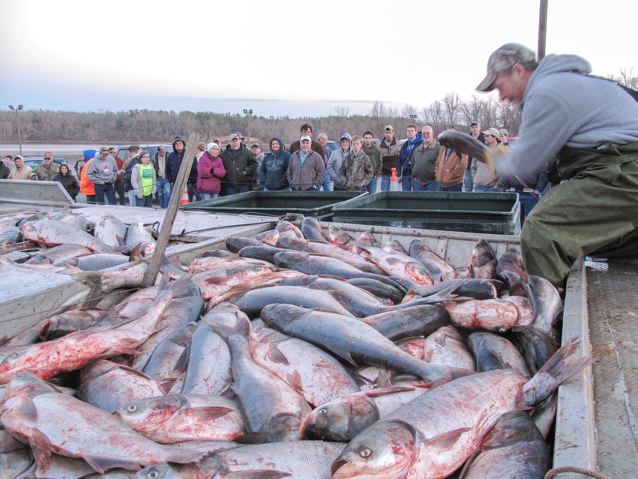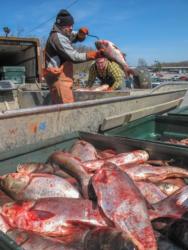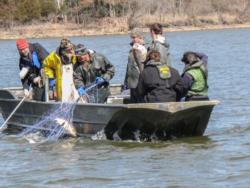Back Story: What to do about jumping carp?

EverStart Series Tournament Director Ron Lappin attended a meeting of stakeholders the other day in which the only topic of discussion was what has become known in colloquial fishing language as “jumping carp.”
Silver and bighead carp, which are inclined to jump clear of the water at the approach of a boat, have infested the lower Tennessee River and are becoming more numerous in the Mississippi, Ohio and Missouri River drainages. They’re reproducing like cockroaches and competing with native baitfish and juvenile sport fish for food – and through sheer numbers, they’re winning.
If the nefarious Asian carp haven’t showed up in your neighborhood yet, stick around – they’re on the way. The biggest reason the nuisance fish are proliferating at a much faster rate than they’re diminishing has nothing to do with an inability to harvest them. In fact, they will practically jump into a boat. Below Kentucky Lake Dam, the carp commit suicide by swimming along the riprapped shore where eager bowfishermen use them for target practice. In March, the Kentucky Department of Fish and Wildlife and League of Kentucky Sportsmen co-sponsored a two-day commercial netting tournament on Kentucky Lake that produced more than 82,000 pounds of silvers and bigheads.
 The real problem with jumping carp is that they don’t seem to fit in any current supply-and-demand model. Typically, the way things get done in this country is that a need or desire for something is created and then served. Marketplace economics kick in: production and delivery, cost and profit. If one component is out of kilter, the machine doesn’t run.
The real problem with jumping carp is that they don’t seem to fit in any current supply-and-demand model. Typically, the way things get done in this country is that a need or desire for something is created and then served. Marketplace economics kick in: production and delivery, cost and profit. If one component is out of kilter, the machine doesn’t run.
In the case of Asian carp, the real problem is that nobody wants to eat the fish – or at least not enough people to create a strong and sustainable commercial demand. Probably there are a lot of reasons for that: the fish’s name is a turn-off, there are more acceptable species such as tilapia and catfish readily available and, like all carp, Asian varieties have a series of small “floating bones” imbedded in their flesh above the backbone that consumers don’t like to deal with.
The protein-rich byproducts of Asian carp – their bones, skins and innards – can be turned into livestock and fish feed, but there’s not a lot of money to be made there. Considering that 50- or 75-pound carp routinely tear up nets worth about $350, many commercial fishermen aren’t too keen on making sets in areas where they know the fish abound. Carp are important dietary staples in the Far East, but the U.S. is a consumer nation, not a supplier, and isn’t set up to process and ship freshly caught fish halfway around the globe. In 2012, for instance, the Department of Commerce’s tally shows that the U.S. imported $16.7 billion in fishery products, and exported $5.13 billion.
 According to Lappin, the meeting group’s consensus was that the best first step to deal with the Asian carp problem is to promote domestic consumption. Hopefully, a domino effect will then cultivate a thriving international market. That might be a reach, but it seems to be the only solution. And such marketing efforts are underway, though they’re taking baby steps for now.
According to Lappin, the meeting group’s consensus was that the best first step to deal with the Asian carp problem is to promote domestic consumption. Hopefully, a domino effect will then cultivate a thriving international market. That might be a reach, but it seems to be the only solution. And such marketing efforts are underway, though they’re taking baby steps for now.
The alarm bells aren’t ringing too loudly now, but they will. And somewhere up ahead, a “United Nations” of scientists, fishery managers, chambers of commerce, tourism councils, fishermen and boating and fishing industry honchos are going to have to get together and tackle the problem. The sheer biomass of Asian carp sweeping toward our fishing future like a giant tsunami isn’t going to disappear by itself. If jumping carp aren’t your concern, they’re most definitely going to be a concern for your children and grandchildren.
Think about it the next time you’re out there bass fishing and a carp jumps clear of the water near you. Consider it a reminder: It’s not going away on its own.